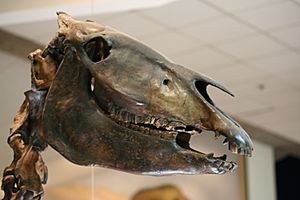Western horse facts for kids
Quick facts for kids Western horseTemporal range: Pleistocene
|
|
|---|---|
 |
|
| Skeleton from the La Brea tar pits | |
| Scientific classification | |
| Kingdom: | |
| Phylum: | |
| Class: | |
| Order: | |
| Family: | |
| Genus: | |
| Species: |
†E. occidentalis
|
| Binomial name | |
| †Equus occidentalis Owen, 1863
|
|
The Western horse (also known as Equus occidentalis) was a type of horse that lived in North America a very long time ago during a period called the Pleistocene epoch. This amazing animal is now extinct, meaning there are no more Western horses alive today.
It was a strong and sturdy animal. It looked a bit like the extinct quagga or the modern zebra. However, even though it looked similar, it was not closely related to either of these species.
Contents
What Was the Western Horse?
The Western horse was a large, powerful animal. It belonged to the Equus genus, which includes all modern horses, donkeys, and zebras. This means it was a true horse, just like the horses we see today.
When Did It Live?
The Western horse lived during the Pleistocene epoch. This time period lasted from about 2.6 million years ago to about 11,700 years ago. It was a time when many large mammals, like mammoths and saber-toothed cats, roamed the Earth.
Where Did It Live?
Fossils of the Western horse have been found across a wide area of North America. This shows that it lived in many different habitats, from grasslands to open woodlands. It was a common animal in its time.
What Did the Western Horse Look Like?
Scientists believe the Western horse was a very strong and muscular animal. It was likely similar in size to a modern horse, but perhaps a bit stockier. Its legs were strong, built for running across open plains.
What Did It Eat?
Like modern horses, the Western horse was a herbivore. This means it ate plants. Its diet mainly consisted of grasses and other low-growing plants. Its teeth were well-suited for grinding tough plant material.
How Did It Live?
It is thought that Western horses lived in herds, much like wild horses do today. Living in groups helped them protect themselves from predators. They likely grazed together, moving across the landscape in search of food.
Why Did the Western Horse Disappear?
The Western horse went extinct around 11,000 years ago. This was at the end of the last Ice Age. Many other large animals also disappeared around this time. Scientists have a few ideas why this happened.
Climate Change
One big reason for its extinction might have been changes in the climate. As the Ice Age ended, the environment changed. Grasslands that the horses depended on might have shrunk or disappeared. This would have made it harder for them to find enough food.
Human Impact
Another possible reason is the arrival of early humans in North America. These humans were skilled hunters. They might have hunted the Western horse, along with other large animals, which could have contributed to their decline.
Finding Out About the Western Horse
Most of what we know about the Western horse comes from its fossils. Scientists have found many bones and teeth of these animals. These fossils help us understand what they looked like, what they ate, and how they lived.
The La Brea Tar Pits
One of the most important places where Western horse fossils have been found is the La Brea tar pits in Los Angeles, California. These tar pits acted like natural traps. Animals would get stuck in the sticky tar, and their bones would be preserved for thousands of years. This site has given us a lot of information about the animals that lived in North America during the Ice Age.
See also
 In Spanish: Caballo occidental para niños
In Spanish: Caballo occidental para niños


